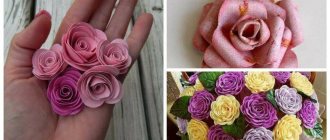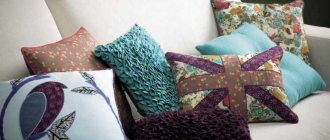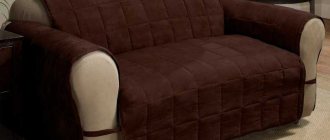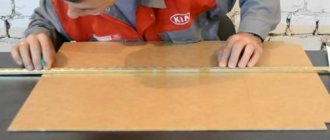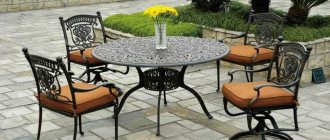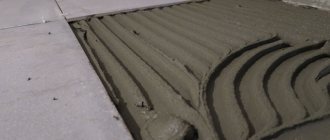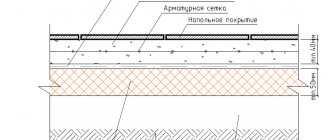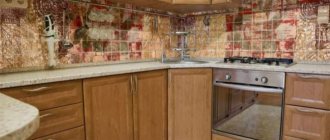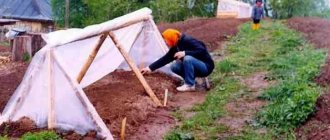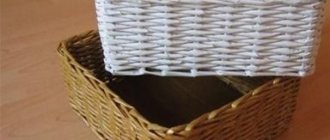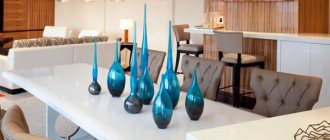Purpose of decorative pillows
Homemade pillows look great on sofas, will serve as an excellent addition to the interior of a child’s room, living room or bedroom, and will make a set of country furniture more comfortable.
A variety of pillows will find their place in any living space, on vacation, and even in a car.
A stylish hand-sewn pillow will be an excellent gift for a loved one, and making interesting options for interior pillows can bring additional income.
Function and purpose of decorative pillows in the home
Decorative pillows for the sofa are created with your own hands, first of all, to create comfort. However, many needlewomen also include in them the function of practicality, when they simply become a necessity for a convenient pastime. Sewing products of this kind have long ceased to be only part of sofas.
They can easily fit into the overall appearance of any room. They can become faithful companions of large beds in bedrooms and children's rooms, as well as small sofas or armchairs in the living room, hallway, kitchen and even balcony.
Sometimes pillows with impressive shapes are often used for playful moments on the floor for the whole family. They are able to perfectly combine practicality and functionality, creating a warm feeling of a homely atmosphere.
Another main function of decorative pillows is to correctly and harmoniously place accents and combine colors in a room.
They can perfectly complement completely incompatible tones in a room if they are combined in their own color scheme.
They will also perfectly bring into the room those shades and colors that are missing there. For example, if your room is made in pastel green colors, then red and blue pillows will not be out of place, which can diversify the interior and add a certain point of contrast.
Less often, such textiles are used to combine certain lines or patterns in a room into one plot.
Types of decorative pillows
Interior pillows are in demand and popular not only as an element of room decor, but as a convenient household item.
Types of decorative pillows are divided into:
- classically shaped products for sofas that make relaxation more comfortable,
- rollers for beds and upholstered furniture,
- special pillows for the kitchen or dining room,
- floor pillows for a children's room or recreation area,
- small camping pillows that you can take with you outdoors,
- car pillows that make the trip more comfortable.
Pillows can have a classic or non-standard shape, depending on the purpose and imagination of the master. The size and design depend on the application of the decorative product.
Types of pillows
There are an unlimited number of types of pillows, different shapes, sizes and purposes. Duma can look not only like a classic pillow, but also like a fairy-tale character, a car or an animal. Several main types used in decoration:
- A cushion is a small pillow, the second name of which is dumka, often used not only as an accessory, but also as a soft cushion under the head during daytime sleep.
- Sectional - consists of several volumetric inserts sewn together with ribbed inserts, in appearance it resembles sewing in a patchwork style.
- Turkish - often decorated with currency exchangers and tassels, the shape is slightly oblong, the embroidery on the fabric is reminiscent of oriental patterns.
- Quilted - comes in various shapes: rectangular, oval, round or square. A distinctive feature of this pillow is the quilted surface of the cover.
- Oxford - features additional stitching around the perimeter, which separates the border without padding. The piping accompanies the pillow around the entire perimeter.
You might be interested in this: The procedure for sewing a bedspread for a sofa with your own hands
Oxford pillow
Fabrics
To make decorative pillows, it is better to take dense fabrics:
- natural cotton and linen materials,
- denim or knitted fabric,
- different types of fur and satin,
- furniture fabrics for upholstery.
To create a good pillow with your own hands, it is important to choose the right material in terms of properties, color and texture, so that the decorative product complements your home interior.
Do-it-yourself bead brooch - 105 photos and video description of how to quickly and easily weave a broochDIY bird feeder - step-by-step master class and ideas for beginners and schoolchildren (155 photos)
Do-it-yourself beads: 120 photos and video description of how to weave beads
Master classes on creating creative pillows
DIY decorative pillows for a sofa can have a huge number of variations and ideas. It is completely unrealistic to implement all of them, and it is not worth it.
After all, they must create an overall holistic picture in the room. And products of different shapes and technologies will not visually create the same range. Let's look at some interesting ideas.
Materials for creating beautiful and elaborate pillows can be found in every home, and there is absolutely no need to spend extra money on shopping in specialized fabric or accessories stores.
What we may need:
- scraps of fabric of different shapes and lengths;
- sharp large scissors;
- multi-colored threads of different densities;
- crayons for markings or regular pencils;
- sewing needles (ideally a sewing machine);
- various accessories.
Important! When combining different fabrics, pay attention to their density. They must fit together. When cutting soft, loose fabrics, you should not make appliqués or zoning the product - this will complicate your task.
DIY pillows for the sofa - master class No. 1
Two rectangles are cut out from soft fabric. They will become the basis for the case.
Next, using sewing chalk, we create clear lines vertically, an average of 2-2.5 centimeters apart from each other.
We cut our own blanks from the same fabric in advance - thin strips measuring 1.5 by 10 centimeters.
The finished pieces are laid out tightly along the drawn lines and sewn on by hand (better - machine stitching).
The finished sewn fringe is folded to one side, pressed with hands or with an iron, and the second batch is sewn on the adjacent vertical line.
Sometimes craftswomen sew blanks in a checkerboard pattern to create a voluminous effect, but this requires more effort and time. You can fill the space of the pillow as much as you like until the result is visually pleasing to you.
After all work is completed, the backdrop is carefully sewn into the finished front side and stuffed from the inside with suitable material. Foam rubber or padding polyester is best.
Filler
To fill pillows, natural, synthetic non-woven materials and natural raw materials are usually used.
Natural padding includes:
- down and/or feather of a bird,
- animal fur.
Such a filler requires high-quality care, since small parasites can appear in it.
Herbal filling involves the use of various aromatic herbs. The service life of such a pillow is short, it must be protected from moisture. Plant content has a positive effect on human health.
Synthetic fillers include non-woven artificial materials:
- Do-it-yourself dolls made of fabric - 145 photos and video description of how to sew a beautiful doll quickly and easily
- How to sew curtains for the kitchen - a detailed description of how and what to sew curtains for the kitchen from (video + 135 photos)
- Do-it-yourself felt toys: ideas, patterns, templates and felt patterns (135 photos and videos)
- holobiber,
- foam rubber,
- padding polyester,
- small silicone beads.
The advantages of synthetic padding are ease of maintenance and long service life.
Beginning of work
The first step in creating an interior pillow is to think about its purpose and appearance.
Having decided on the application, design, color and size of the future product, it is important to choose the right fabric for sewing.
The material should be in harmony with the rest of the home furnishings and correspond to the intended sketch.
What fabric to make a pillow from
There is a wide range of fabrics, but not every one is suitable for creating a pillow. The main criterion is that the material is not highly electrified and prevents dust from getting into the packing.
There are several good options for the best material to make a pillow from:
- silk;
- atlas;
- satin;
- calico;
- bike;
- denim;
- upholstery fabrics for furniture.
To sew a pillow, you can choose one type of fabric, or you can combine 2-3 types, the main thing is that they fit each other and look beautiful.
Features of work
When sewing pillows, it is important to take into account the small nuances of working on this decorative item. The product consists of a pillowcase, filling and decorative cover. The top cover is made so that it is easy to remove for cleaning or washing.
When cutting, the size of the cover should be made a couple of centimeters larger than the pillowcases.
When considering how to sew decorative pillows with your own hands, it is worth considering these features of the work.
About buffs
Puffs on a suitable fabric, smooth and glossy, are another matter. When done correctly, they can be vacuumed and hand washed without any problems. And making all this splendor is not as difficult as it seems. First you need to learn how to read the diagrams for assembling puffs (assembling them, as sewing makers say).
As an example, diagrams for assembling simple puffs are shown in Fig. below. All puff patterns are built on an orthogonal-diagonal grid, the module of which (the side of the square) is 2-7 cm, depending on the size of the product and the density of the fabric. The grid in the diagram can be shown explicitly, as on the right in the figure, or its nodes can only be marked with dots, as on the left. The mesh is applied to the back of the workpiece with a textile marker in a mirror image.
Further, areas that are contracted (collected, assembled) into a buffer are marked either with converging arrows (on the left) or red lines (on the right), and those that are not contracted are marked with simple thin lines. The puffs can be assembled either with one thread or separately. The first method is for the lazy, because... a web of threads is formed from the inside. In any case, each puff is assembled with at least 3 stitches 4-5 mm wide, unless otherwise indicated in the notes to the pattern.
Popular articles Decor of pipes inside the apartment
Examples of puff patterns for pillows
Then, the assembly sequence. It is produced in horizontal or vertical rows, again, unless otherwise indicated in the description of the pattern. In the case where the rows are indicated explicitly (on the left), they are displayed in numbering order and the buffs in the row are also assembled by numbers; here – Row 1 1-2, 3-4, etc., then Row 2 and so on. In the absence of an explicit indication of the rows (on the right), the puffs are assembled simply in numerical order; according to the diagram on the right - 1-2, 3-4, 5-6, 7-8, etc.
Try to assemble any scrap of fabric into puffs according to these entry-level patterns, and you will see that it will take little time, even if you assemble one at a time. And then watching a selection of master classes on making pillows with puffs that are much more spectacular and complex won’t seem like a nightmare:
Video: DIY buffalo pillows, master classes
Work on creating a decorative pillow
It’s better to prepare everything for work in advance.
In addition to the fabric, you should stock up on:
- scissors,
- life-size patterns,
- a piece of dry soap or chalk,
- needles,
- threads,
- sewing machine,
- decorative elements.
The procedure for making a simple interior pillow
It is recommended to wash new fabrics before cutting parts, as they may shrink.
- Having placed the pattern on the wrong side of the material, it should be traced along the contour. For convenience, the pattern should be secured with pins.
- The parts are cut with scissors, taking into account the margin for seams.
- Having folded the parts of the product with the right side inward, sew the seams. It is better to sew using a sewing machine, but you can do the work by hand.
- One side is not completely stitched; the product must be turned inside out and ironed.
- Decorate the pillow, fill it and sew up the seam.
A simple square pillow will not require much effort or time to work. A master class on making decorative pillows with your own hands can be easily found online and in video format.
Preparing to sew
Since soft decorative objects are often moved from place to place, dropped, and children play with them. Therefore, to create them you need to choose durable fabric, safe padding with an elastic texture that does not change its shape under physical influence. Sewing beautiful sofa cushions consists of several stages: choosing the material, selecting the appropriate padding and sewing itself.
Choosing fabric
Choosing fabric for thinking is the very first and most important stage. The main quality of the selected material should be strength. If you still have no idea how to sew a pillow for a sofa with your own hands, then it is best to choose simple fabrics: cotton or chintz. Also commonly used fabrics: felt, silk, linen, upholstery material or calico. For knitted pillows, it is best to use old knitted sweaters or unnecessary bulky jumpers. An important factor in the material used should be color fastness and texture density so that the padding material does not fall out.
Pros and cons of different types of fabrics
Natural fabrics:
- Calico fabric is easy to care for, has a light and breathable texture. Cons: sensitive to high temperatures, can shrink, easily wrinkled and short-lived material.
- Silk is distinguished by its strength and wear resistance, can be washed at a fairly high temperature (about 110 degrees), and is a highly breathable material. Cons: wrinkles easily, the price is quite high.
- Linen fabric is hypoallergenic, breathable, and washable. Cons: shrinks quickly and wrinkles very easily, the material itself is harsh.
For the interior:
Jeans, flannel and felt are fabrics of denser origin, which have their own characteristics:
- Jeans or denim is a breathable and quite durable fabric, the colors look very stylish and fashionable, and are environmentally friendly. Cons: highly susceptible to fading, hardens and shrinks after washing.
- Fleece is a budget fabric, pleasant to the touch and practical to use, hypoallergenic. Disadvantages: during sewing it frays a lot, which causes certain difficulties, and the fabric is absolutely not elastic.
- Felt - there are no back and front sides, which simplifies its use, a large range of colors, containing 90-100% wool. Cons: pills may appear after washing, it is afraid of high heating temperatures, both during washing and during steam treatment, and if washed incorrectly, it loses its shape.
You might be interested in learning how to cut and sew correctly from scratch alone
Additional Information! When sewing decorative pillows, a combination of fabrics is allowed; one side can be linen and the other silk. It looks unusual and beautiful. You can also create your own patterns from many scraps of different fabrics. This type of needlework is called patchwork.
Curtain to match the style of pillows
Filler selection
Just sewing a pillowcase is only a small part of the work done; it still needs to be stuffed. There are two types of padding:
- Natural filler (plant or animal origin).
- Artificial filler.
The advantages of natural fillers, in this case of animal origin, are their long service life, practically no caking, and maintain good sanitary and hygienic properties. The only thing is that such material is rarely used when sewing decorative pillows, since they are not fluffed like sleeping pillows. Such fillers include feathers and down.
Fillers of plant origin are often used for medicinal purposes or for people with certain types of allergies to down or synthetics. The filling can be: bamboo, medicinal herbs, buckwheat husks or hop cones. Cons: this material has the ability to rot, become damp and even rot, so it requires very careful care.
Original design
Artificial filler: holofiber and synthetic fluff. These are the most recommended materials that will not lose their elasticity over the years. Cotton wool, padding polyester, etc., these materials are absolutely not suitable for stuffing decorative pillows, as they tend to quickly clump and cake.
For pillows in a children's room, it is best to use silicone granules; also, this type of material does not get wet and is hypoallergenic.
Important! Dummies with artificial filling can be easily washed in a washing machine, eliminating accumulated dust, which is not permissible with filling made from natural materials.
Necessary items for sewing:
- Scissors;
- Fabric and padding, zipper (for certain types of pillows);
- Sewing machine (can also be sewn by hand);
- Tailor's pins and needles;
- Meter or simple ruler, chalk;
- Threads, pattern on cardboard or instructions;
- Iron.
Step-by-step master class on sewing pillows
All materials are prepared, tools are collected, you can start sewing the pillow:
- We decide what size and shape the thought will be, let’s say a square, 50x50 cm.
- On the laid out fabric from the wrong side you need to draw two 50x50 squares, adding 2-3 cm around the perimeter for the seam.
- Folded squares with the front part facing inward should be pierced with pins along the perimeter so that the fabric does not move out and cut out.
You might be interested in: Creating patterns and sewing tops in lingerie style
Furniture cushion
The next stage is stitching the prepared parts:
- You need to start sewing by stitching 3 sides of the cut pieces, without removing the pin so that the fabric does not slip. Retreating the same 2-3 cm that were left in reserve.
- Bend the resulting seams to one side and iron them thoroughly, then turn them right side out.
- Fill the resulting pillowcase with the selected filling and stitch the remaining side, bending the seam inward.
Large sofa cushion
Cushions for sofas of impressive size require good skill and acquired practice during sewing. The sewing algorithm is exactly the same as for standard products that were described earlier. It is enough to increase the dimensions of the finished pattern to the required parameters. Large sofa cushions can also be made under furniture, covered with upholstery furniture textiles.
Cushion
The furniture cushion that complements the sofa usually has a simple geometric shape. Most often it is a rectangle.
Such items are subject to wear and tear during use faster than the sofa itself. The opportunity to buy a similar pillow is not provided by furniture manufacturers.
Therefore, there is a need to sew such a pillow yourself. This is a simple job, most of the success of which lies in the correct selection of material for the cover.
If possible, the fabric should be found similar to the upholstery of the sofa. If there is no such fabric, then you need to think through the design of a new pillow so that it fits organically into the interior.
In any case, the texture should match the upholstery of the sofa, and the color should be in harmony with the design of the room.
The easiest way to copy a factory copy is to rip open the old one and measure the cover.
Using these measurements, draw a drawing, cut and seam the parts of the new product.
How to sew covers for sofa cushions
Detailed instructions for sewing a pillowcase. It is better to take colorful fabric for this work so that the item turns out beautiful.
The photo shows an example of bright crafts that can be made using the technology described below.
To sew a cover for a sofa cushion, take:
- small pieces of fabric;
- pins;
- threads of suitable colors;
- scissors.
We measure out the bedding. We multiply the resulting value by two - we get the width of the segment, and the length is cut to the size of the pillow. Don’t forget to add 3 cm to the seams in width, and 1 cm in length.
Laying the wrong side up, fold one edge of the fabric and iron it thoroughly. Then we wrap it again and iron it. We machine stitch the folded edges closer to the inside. We do the same with the second opposite edge. The pillowcase for the sofa cushions is ready.
Fold one side of the rectangle halfway. Then we turn the workpiece over and bend the second edge so that it overlaps the first. We do this in such a way that the middle part is equal to the size of the pillow.
Stepping back a centimeter from the edge, sew from the top, then from the bottom. You can additionally go through a zigzag.
Making a pillowcase for a sofa cushion is coming to an end. All that remains is to turn the craft inside out and put it on.
Having straightened all the edges, turn the finished product over and place it on the sofa. You can start making the next pillowcase.
These are the beautiful things you can make with your own hands.
Decorative design
The most fun part of the creative process of creating an interior pillow is thinking about its design.
The easiest way is to use plain textured fabrics, the color of which matches the design of the room.
Pillows for a children's room often serve as an element of games. They should have bright colors and interesting design.
In children's design, bright applications on cartoon and fairy tale themes, original pillow toys in the shape of stylized animals or famous cartoon characters are appropriate.
You can make your own children's decorative pillows from a bright T-shirt with an original design that is too small for the child. Patterns for sewing funny children's pillows can be easily found online or drawn yourself.
You can complement the interior pillow with stylish appliqué, embroidery, satin ribbons, additional details in the form of an overhead bow or animal ears, fringe or frills.
External design depends on the skill and imagination of the craftsman, as well as on the purpose of the product.
Popular design trends allow the use of appropriate decorative methods: patchwork, stylized ornaments, thematic embroidery, tassels, bows, and so on.
The main thing is that the result of the work is a comfortable decorative pillow that harmoniously fits into the interior design.
How to choose the right one
Before buying this decorative item, you should pay attention to its shape and the general style of the room. According to the design of the pillows there are:
According to the design of the pillows there are:
- Standard. Classic square shape.
- Sectional. There is a clear side seam between the top and bottom surfaces. This pillow is utilitarian; it provides the model with good volume.
- Quilted. There are decorative seams along the surface of the cover. Thanks to them, the product holds its shape better and the fabric does not wrinkle.
- Turkish. Curvy models with folded or gathered folds.
- Rollers. They are used as armrests or headrests and represent a complex elongated structure.
Popular articles Wool bunny
Interior pillows are designed not only for comfort, but also perform decorative functions.
By style they are:
- Classic. The shape is geometrically correct. Made from leather, velvet, tapestry fabric.
- Minimalistic. Modest one-color models. Jewelry is not allowed.
- Glamorous. There is room for your imagination to run wild. Fur and silk are used to make them. The shape can be in the form of hearts, lips, or the eyes of a beauty. Embroidered with rhinestones, beads, beads. Decorated with lace and ruffles. Colors - the brighter the better. Everything should sparkle, sing and hurt the eyes with luxury.
- Eastern. Eastern luxury implies elegance. Expensive materials and bright colors are used for production. Decorations are required, but they should emphasize the style. This could be elegant embroidery around the perimeter, fringe, tassels.
- Country. This style implies rural simplicity and environmental friendliness. The form is standard. For the cover, use any cotton or coarse fabrics such as burlap. You can take denim.
- High tech. This is a very strict style that does not tolerate excesses. Genuine leather or fabric imitation animal skin works well here.
You should also decide whether the pillow will be used only as a decoration or whether children will be able to play with it. Perhaps one of the family members will want to take a nap on it.
Photos of decorative pillows with your own hands
Tell your friends
